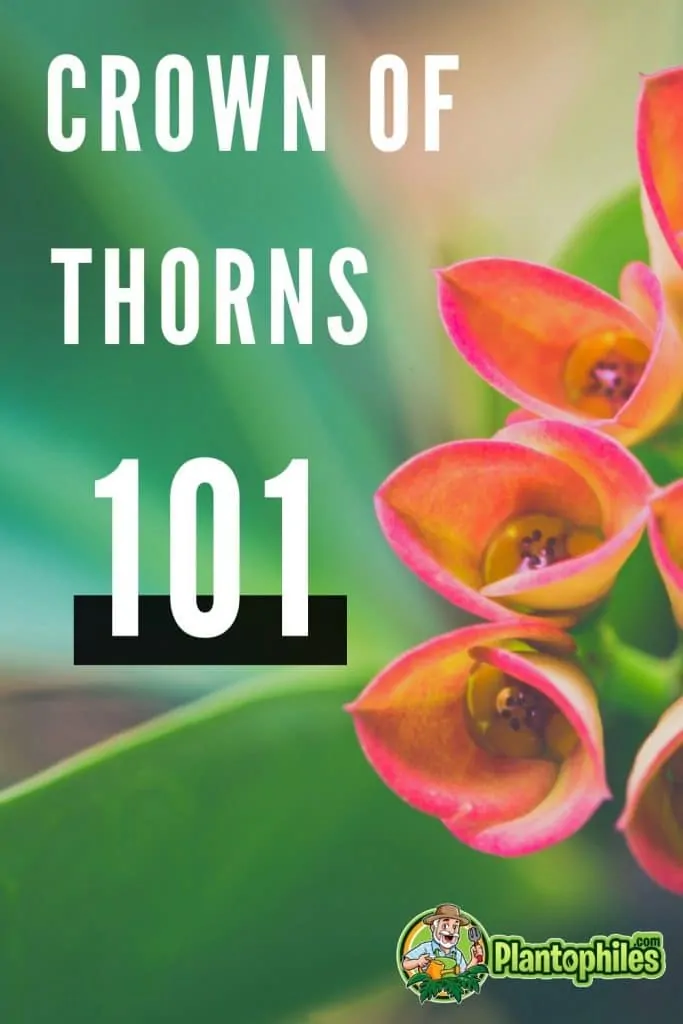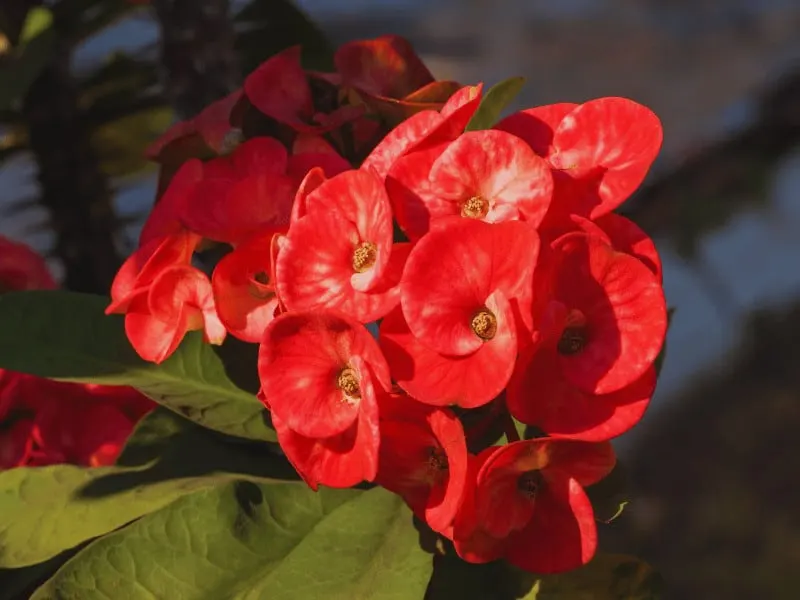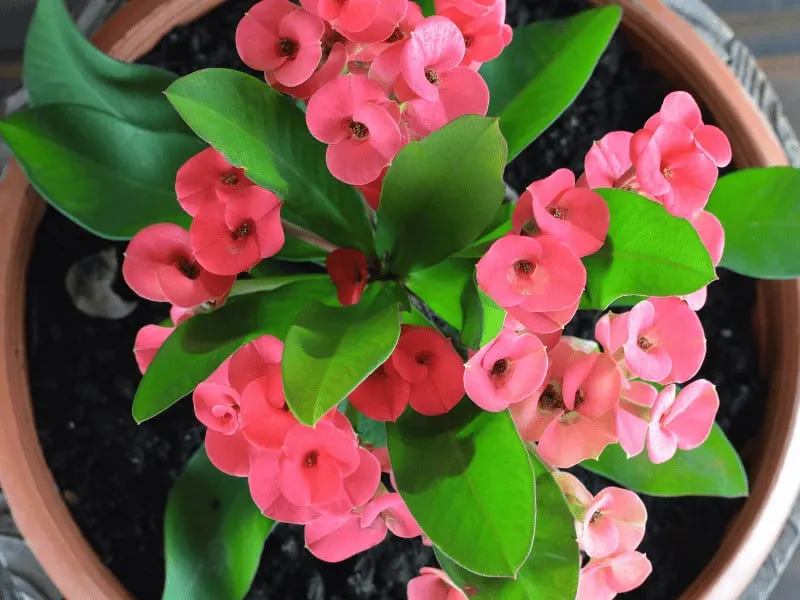You are looking for a Crown of Thorns care guide and want to learn more about Euphorbia milii (Latin name).
Crown of Thorns Plant
Crown of Thorns is a desert succulent from Madagascar. Euphorbia milii, by its botanical name, is a member of the Spurge family or Euphorbiaceae.
Plants in this family, like the Crown of Thorns, are known for their fleshy green leaves and small flowers that grow in clusters.

Crown of Thorns Plant Care Takeaways
| Species | Euphorbia milii |
|---|---|
| Synonyms | Crown of thorns, Christ plant |
| Family | Euphorbiaceae |
| Genus | Euphorbia |
| Growth | Compact, bushy |
| Height | 3.0ft / 0.9m |
| Width | 3.0ft / 0.9m |
| Soil | Well-draining soil mix |
| Watering | 7.0 – 14.0 |
| Light | Bright indirect |
| Temperature | 60.0 – 80.0°F / 15.6 – 26.7°C |
| Humidity | 40.0 – 60.0% |
| Fertilizer | Once a month in spring and summer |
| Propogation | Stem cuttings, seeds |
| Toxicity | Toxic to humans and animals such as cats and dogs. Contains white milky sap. |
Table of Contents
Crown of Thorns Care
Succulents are commonly known for their easy-to-please nature regarding indoor care. Even so, you should still be aware of the different needs involving keeping your Crown of Thorns alive.
The following lists all of their general requirements for daily care.

Soil
Soil requirements aren’t all that strenuous. The main preference that they have is for the soil to be well-draining, sandy, and mixed with organic material such as humus.
Taking note of which soil you purchase will greatly impact your Crown of Thorns. These plants do not thrive when placed in a pot with the average commercial product.
Light
Provide bright indirect sunlight.
Several succulents prefer to be placed in an area with direct sunlight. This Euphorbia is more sensitive, needing plenty of light, though not for as long as expected.
They do like to be placed in direct sunlight, but this will cause the flowers to fade in color. Instead, your plant would do best when given lots of indirect, bright light.
Watering
The first rule of watering your Crown of Thorns is to include a good amount of drainage holes on the bottom of the pot. The needs for these plants are relatively low for a flowering plant.
This depends on the temperature at which you place your Crown of Thorns. In a warmer room, you should provide more moisture, being careful not to overwater. A good tip is to feel the inch below the soil’s surface. If it is dry, then it needs a thorough watering.
On par with most succulents, the Crown of Thorns plant only has a few recommendations regarding a regular watering schedule. You may accidentally forget to water this Euphorbia. In those cases, it’s easy to nurture back to life.
The following section will tell you how much water to add, how often, and any tricks that have helped others.
Temperature
The ideal temperature is 60-80°F (16-27°C).
Preferring warmer temperatures, the Crown of Thorns plant is tolerant to a wide range. Even if your house reaches above 79 degrees Fahrenheit (26 degrees Celsius), this Euphorbia won’t be critically impacted.
They can survive any temperature if it does not exceed 2 Degrees Celsius. This is only a short period, though, as the leaves will start to fall off. An indoor Crown of Thorns plant should be kept around 12 degrees Celsius for the best results.
Humidity
The optimal humidity is 40-60%.
Being a succulent, this Euphorbiaceae member is more particular about the temperature requirements. Their humidity needs are relatively low, and they prefer drier living conditions.
This makes them highly coveted by those with indoor plants. The Crown of Thorns does not need additional misting, making your job much easier.
Fertilizer
Fertilize once a month using a well-balanced fertilizer in spring and summer.
The Crown of Thorns plant is fairly consistent in blooming, producing large, vibrant flowers when they do. Adding a fertilizer will not harm the plant if you keep the season in mind.
When these plants are first planted, they’ll need all the help they can get. Most choose to give them an undiluted solution during this time. Afterward, fertilizer can be added at half the recommended dose during the warmer months.
Propagation
Crown of Thorns can be propagated through several methods, such as stem cuttings, in water, and seed germination. Out of all these techniques, cuttings seem to be the most commonly used.
You may not know this, but Euphorbia milii is a long-lasting flowering succulent, sometimes known to last up to 50 years. This rings true for those who choose to keep these plants indoors.
Stem-Cuttings Propagation
- Decide which individual you want to copy, preferably with flourishing blooms throughout the year.
- Use scissors to make a two- to four-inch (10 cm) cut on an older stem. Be sure to keep a few leaves and buds with this cutting.
- Once you have your cutting, run it under cold water and place it to the side for a few days. Drying the stem out before placing it into the soil will decrease the chance of developing root rot.
- Place your dried-out stem cutting into a pot with fresh, slightly sandy soil, ensuring it is at least two inches deep.
- Drizzle the soil with water, letting it dry out before adding more. Set your new cutting in a window with plenty of warm, indirect sunlight.
- Check back every so often. Roots should form around two weeks after it has been potted. Once this happens, you can transfer it to a new container.
Growth

Euphorbia milii is a slow grower. It reaches 3 feet tall (0.9m) and 2 feet wide (0.6m). When living in outdoor settings, they stretch out a little more, sometimes even a staggering 6 feet in height.
The reason for this slower growth is largely due to their large flowers. It takes a lot of energy to bloom as regularly as the Crown of Thorns does.
Potting
Repot every 2-3 years.
They aren’t known for getting root-bound, so owners don’t need to worry about them becoming cramped in their living space.
Crown of Thorns Pruning
The Crown of Thorns plant is considered an evergreen shrub, sometimes growing unruly. It takes them a while to get to this point, usually needing to be trimmed back after the second or third year.
One important thing to note is that these plants are considered toxic. If you were to rub your eyes after handling the prickly stems, you would experience a good amount of irritation.
As for the pruning process itself, it isn’t necessarily a requirement. If you do not like the look of a bushy houseplant, you can take off a few stems.
The best method is to make your incisions at the base of the stem so that it won’t grow back stubby. At this time, you can also remove any dying or dead growth. This will preserve the overall health of your Crown of Thorns plant.
Crown of Thorns Problems
As many plant owners know, several conditions and diseases can affect the growth and wellbeing of your indoor collection.
We’ve taken the liberty to highlight two of the most common problems that affect these plants, as well as some ways that you can help reduce further damage.
Yellow Leaves
Cause: The yellowing of leaves in combination with them falling off the branch can be several factors. The two most common causes are either over-watering or a cold draft.
Remedy: Determining which problem your plant is experiencing should be the first step. Taking a step back from watering can quickly allow you to see if the leaves are turning yellow due to excessive moisture. If no change happens, look into any potential drafts in your home.
Drying Leaves
Cause: The lower leaves on a Crown of Thorns plant will begin to fade up and fall off sometimes because the individual lacks light or moisture. Another potential cause is that your succulent has too much heat.
Remedy: If your plant is experiencing too much heat, this may also impact the amount of moisture that’s getting down to the roots. Attempt to solve the warmth problem first and go from there. You won’t be able to save the leaves that have already shriveled up, but it will stop future dead foliage. After addressing possible heat issues, move your plant to an area with less direct light.
FAQ
How do you get a Crown of Thorns plant to bloom?
Following the bare needs is a great start to allowing plentiful blooms. Other tips include the use of fertilizer as well as regular pruning.
What colors does a Crown of Thorns come in?
Known for their large flowers, they vary significantly in color. They can vary between red, yellow, white, and pink colors. There are even specially modified hybrids that have larger and flashier flowers.
Where does the Crown of Thorns plant name come from?
This prickly, beautiful succulent was named to symbolize the crown that Jesus Christ wore at the time of his crucifixion. Legends state that the stems belonging to this plant were used in that time frame.
The Last Crown
The Crown of Thorns plant is a plant with a rich history that is easy to care for and that fits you nice blooms if cared for the right way.

Daniel has been a plant enthusiast for over 20 years. He owns hundreds of houseplants and prepares for the chili growing seasons yearly with great anticipation. His favorite plants are plant species in the Araceae family, such as Monstera, Philodendron, and Anthurium. He also loves gardening and is growing hot peppers, tomatoes, and many more vegetables.


